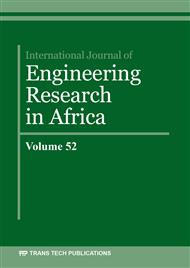[1]
Abdel-Fataha, M. A., Sherif, H. O., and Hawash, S. I. Design parameters for waste effluent treatment unit from beverages production. Ain Shams Engineering Journal, 8 (2017) 305-310.
DOI: 10.1016/j.asej.2016.04.008
Google Scholar
[2]
Olakunle, M. S., and Ityokumbul, M. T. Industrial Wastewater Management: The Water Pinch Analysis. International Journal of Research in Engineering and Technology, 2(7) (2014) 33-40.
Google Scholar
[3]
Hussain, R., Sattar, S., Khan, M. H., and Nafees, M. Low Cost Wastewater Treatment at Beverage Industry, Hattar Industrial Estate, Pakistan - A Case Study. International Journal of Environmental Protection, 3(11) (2013) 23-28.
Google Scholar
[4]
Parawira, W., Kudita, I., Nyandoroh, M., and Zvauya, R. A study of industrial anaerobic treatment of opaque beer brewery wastewater in a tropical climate using a full-scale UASB reactor seeded with activated sludge. Process Biochemistry. 40 (2005) 593–599.
DOI: 10.1016/j.procbio.2004.01.036
Google Scholar
[5]
van der Merwe, A., and Friend, J. Water management at a malted barley brewery. Water SA. 28(3) (2002) 313-318.
DOI: 10.4314/wsa.v28i3.4900
Google Scholar
[6]
Alao, O., Arojojoye, O., Ogunlaja, O., and Famuyiwa, A. Impact Assessment of Brewery Effluent on Water. Sciencepub. 2(5) (2010) 21-28.
Google Scholar
[7]
Jaiyeola, A. T., and Bwapwa, J. K. Treatment technology for brewery wastewater in a water-scarce country: A review. South African Journal of Science. 112(3-4) (2016) 1-8.
DOI: 10.17159/sajs.2016/20150069
Google Scholar
[8]
Manan, Z. A., Tan, Y. L., and Foo, D. C. Targeting the Minimum Water Flow Rate Using Water Cascade Analysis Technique. American Institute of Chemical Engineers Journal. 50 (2004) 3169-3183.
DOI: 10.1002/aic.10235
Google Scholar
[9]
Bedu-Addo, K., and Akanwarewiak, W. G. Determination of the pollution loads of Brewery X and the impacts of the pollutant on the Sisai River. Journal of Public Health and Epidemiology. 4(10) (2012) 316-319.
DOI: 10.5897/jphe12.019
Google Scholar
[10]
Noorjahan, C., and Jamuna, S. Physico-Chemical Characterisation of Brewery Effluent and Its Degradation using Native Fungus - Aspergillus niger, Aquatic Plant - Water Hyacinth- Eichhornia sp and Green Mussel –Pernaviridis. Journal of Environment and Earth Science. 2(4) (2012) 31-40.
Google Scholar
[11]
Driessen, W., and Yspeert, P. Anaerobic treatment of low, medium and high strength effluent in the agro-industry. Water Science and Technology. 40(8) (1991) 221-228.
DOI: 10.2166/wst.1999.0425
Google Scholar
[12]
Mielcarek, A., Janczukowicz, W., Ostrowska, K., Jóźwiak, T., Kłodowska, I., Rodziewicz, J., and Zieliński, M. Biodegradability evaluation of wastewaters from malt and beer production. Journal of Institute of Brewing and Distilling. 119 (2013) 242-250.
DOI: 10.1002/jib.92
Google Scholar
[13]
Fakoya, M. B., and van der Poll, B. The feasibility of applying material flow cost accounting as an integrative approach to brewery waste-reduction decisions. African Journal of Business Management. 35(6) (2012) 9783-9789.
DOI: 10.5897/ajbm12.678
Google Scholar
[14]
Etuk, E. N., Ntiedo, H. I., and Bassey, E. N. Water Use and Waste Water Minimisation in a Brewery Case Study Using Pinch Technology. Journal of Nigerian Society of Chemical Engineers. 24 (2009) 60-70.
Google Scholar
[15]
Parand, R., Yao, H. M., Tadé, M. O., and Pareek, V. Composite Table Algorithm - A Powerful Hybrid Pinch Targeting Method for Various Problems in Water Integration. International Journal of Chemical Engineering and Applications. 4(4) (2013) 224-228.
DOI: 10.7763/ijcea.2013.v4.300
Google Scholar
[16]
Tan, Y. L., Manan, Z. A., and Foo, D. C. Retrofit of Water Network with Regeneration Using Water Pinch Analysis. Institution of Chemical Engineers (IChemE) Journal. 87 (2007) 305-317.
DOI: 10.1205/psep06040
Google Scholar
[17]
APHA (1992). Standard Methods for the Examination of Water and Wastewater. Washington, DC: American Public Health Association.
Google Scholar
[18]
Ademoroti, C. M. (1996). Standard Methods for Water and Effluents Analysis. Foludex Press Ltd, Ibadan, Nigeria, 2-51.
Google Scholar
[19]
Wang, Y. P., and Smith, R. Wastewater Minimisation. Chemical Engineering Science. 49(7) (1994) 981–1006.
Google Scholar
[20]
Feng, X., Huang, L., Zhang, X., and Liu, Y. Water System integration of a Brewhouse. Energy Conversion Management. 50 (2009) 354-359.
DOI: 10.1016/j.enconman.2008.09.013
Google Scholar
[21]
Simate, G.S., Cluett, J., Iyuke, S.E., Musapatika, E.T., Ndlovu, S., Walubita, L.F., Alvarez, A.E. The treatment of brewery wastewater for reuse: state of the art. Desalination 273 (2011) 235-247.
DOI: 10.1016/j.desal.2011.02.035
Google Scholar
[22]
Ekhaise, F.O. and C.C Anyansi. (2005) Influence of Breweries Discharge on the Microbial and Physiochemical Quality of Ikpoba River, Nigeria. Afri Journal Biotechnology 4: 1062-1065.
Google Scholar
[23]
Olajire, A.A., The brewing industry and environmental challenges, Journal of Cleaner Production (2012) 1-21.
Google Scholar


